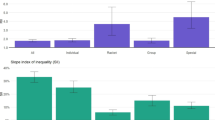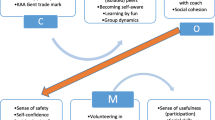Abstract
In the UK, sport is increasingly recognized as a means for promoting social inclusion. However, evaluation, to date, is limited with regard to the achievement of social inclusion through sport. Based on the database of Sport England’s National Benchmarking Service, this paper aims to investigate the extent to which public leisure facilities were used by socially disadvantaged groups in England over the past 10 years. The statistical evidence demonstrates the consistent pattern of numerical under-representation of the most disadvantaged socio-economic group and people aged over 60 years. Furthermore, there were significant and linear decreases in participation of young people aged 11–19 years and disabled people aged under 60 years. Finally, facility type and management type were found to be the main sources of performance gaps in certain indicators. In spite of these findings, further research is still required to investigate whether under-representation and the deterioration of performance are due to constraints or preferences.
Similar content being viewed by others
References
Audit Commission. (2005). Service assessment framework: Technical guide to CPA 2005 for single tier and county councils. London: Audit Commission.
Bailey, R. (2005). Evaluating the relationship between physical education, sport and social inclusion. Educational Review, 57(1), 71–90. doi:10.1080/0013191042000274196.
Berman, Y., & Phillips, D. (2000). Indicators of social quality and social exclusion at national and community level. Social Indicators Research, 50(3), 329–350. doi:10.1023/A:1007074127144.
Burdge, R. (1969). Levels of occupational prestige and leisure activity. Journal of Leisure Research, 1, 262–274.
Campbell, J. C., & Soeken, K. L. (1999). Women’s responses to battering over time: An analysis of change. Journal of Interpersonal Violence, 14(1), 21–40. doi:10.1177/088626099014001002.
Clarke, A. (1956). The use of leisure and its relations to levels of occupational prestige. American Sociological Review, 21, 301–307. doi:10.2307/2089284.
Coalter, F. (1993). Sports participation: Price or priorities? Leisure Studies, 12(3), 171–182. doi:10.1080/02614369300390171.
Coalter, F. (1998). Leisure studies, leisure policy and social citizenship: The failure of welfare or the limits of welfare? Leisure Studies, 17(1), 21–36. doi:10.1080/026143698375231.
Coalter, F. (2000). Public and commercial leisure provision: Active citizens and passive consumers? Leisure Studies, 19(3), 163–181. doi:10.1080/02614360050023062.
Collins, M. (2003). Sport and social exclusion. London: Routledge.
Collins, M. (2004). Sport, physical activity and social exclusion. Journal of Sports Sciences, 22(8), 727–740. doi:10.1080/02640410410001712430.
Collins, M., Henry, I., & Houlihan, B. (1999). Sport and social inclusion: A report to the Department of Culture, Media and Sport. Loughborough: Institute of Sport and Leisure Policy, Loughborough University.
Collins, M., & Kennett, C. (1998). Leisure, poverty, and social inclusion: the growing role of leisure cards in public leisure services in Britain. Local Governance, 24(2), 131–142.
Curry, N. (1994). Countryside recreation, access and land use planning. London: E & FN Spon.
Curry, N., Joseph, D., & Slee, B. (2001). To climb a mountain? Social inclusion and outdoor recreation in Britain. World Leisure, 3, 3–15.
DCMS. (1999). Arts and sports: A report to the social exclusion unit. London: Department for Culture, Media and Sport.
DCMS. (2001). Building on PAT 10: Progress report on social inclusion. London: Department for Culture, Media and Sport.
Donnelly, P., & Coakley, J. (2002). The role of recreation in promoting social inclusion. Toronto, ON: Laidlaw Foundation.
Driver, P., Brown, P., & Peterson, G. (1991). Benefits of leisure. College Station, PA: Venture Publishing.
Duhaime, G., Searles, E., Usher, P., Myers, H., & Fréchette, P. (2004). Social cohesion and living conditions in the Canadian Arctic: From theory to measurement. Social Indicators Research, 66(3), 295–317. doi:10.1023/B:SOCI.0000003726.35478.fc.
Gratton, C., & Taylor, P. (2000). Economics of sport and recreation. London: Spon.
Kelly, J. (1996). Leisure (3rd ed.). Englewood Cliffs, NJ: Prentice Hall.
Lee, J. H., Scott, D., & Floyd, M. F. (2001). Structural inequalities in outdoor recreation participation: A multiple hierarchy stratification perspective. Journal of Leisure Research, 33(4), 427–450.
LIRC. (2002). Sport England Benchmarking Service for sports halls and swimming pools- national benchmarks 2001. Unpublished report. Sheffield: Leisure Industries Research Centre, University of Sheffield.
Nicholls, S. (2001). Measuring the accessibility and equity of public parks: A case study using GIS. Managing Leisure: An International Journal, 6(4), 201–219.
Robinson, L., & Taylor, P. (2003). The performance of local authority sports halls and swimming pools in England. Managing Leisure: An International Journal, 8(1), 1–16.
Sport England. (1999). Best value through sport: The value of sport. London: Sport England.
Sport England. (2000a). Performance measurement for local authority sports halls and swimming pools. London: Sport England.
Sport England. (2000b). Sports participation and ethnicity in England: National survey 1999/2000. London: Sport England.
Sport England. (2001). Disability survey 2000: Young people with a disability. London: Sport England.
Sport England. (2002). Adults with a disability and sport: National survey 2000–2001. London: Sport England.
Sport England. (2004). Participation in sport: Results of the general household survey 2002. London: Sport England.
Sport England. (2006a). No limits: Sport England’s equity policy. London: Sport England.
Sport England. (2006b). Understanding participation in sport: What determines sports participation among recently retired people?. London: Sport England.
Tacon, R. (2007). Football and social inclusion: Evaluating social policy. Managing Leisure: An International Journal, 12(1), 1–23.
Taylor, P. (2004). The power of positive thinking. Recreation, December, 35–37.
Taylor, P., & Godfrey, A. (2003). Performance measurement in English local authority sport facilities. Public Performance and Management Review, 26(3), 251–262. doi:10.1177/1530957602250234.
Veal, A. J. (2002). Leisure and tourism policy and planning (2nd ed.). Oxford: CABI International.
Wilson, L. (2006). Developing a model for the measurement of social inclusion and social capital in regional Australia. Social Indicators Research, 75(3), 335–360. doi:10.1007/s11205-004-2527-6.
Author information
Authors and Affiliations
Corresponding author
Rights and permissions
About this article
Cite this article
Liu, YD. Sport and Social Inclusion: Evidence from the Performance of Public Leisure Facilities. Soc Indic Res 90, 325–337 (2009). https://doi.org/10.1007/s11205-008-9261-4
Received:
Accepted:
Published:
Issue Date:
DOI: https://doi.org/10.1007/s11205-008-9261-4




